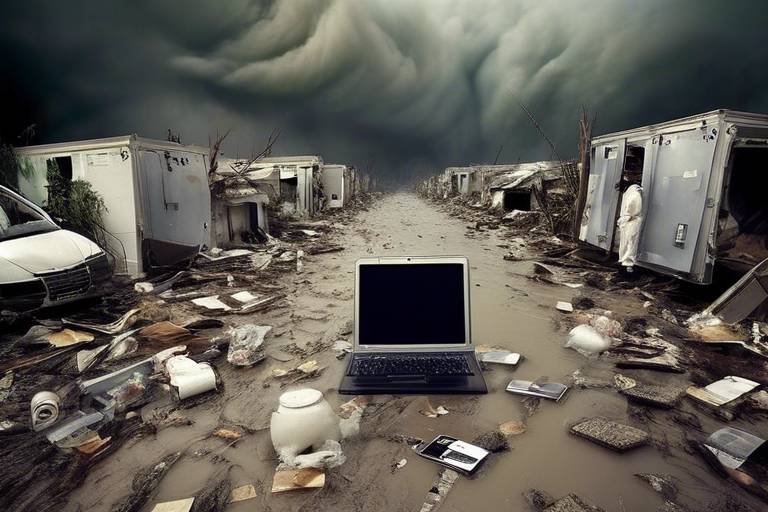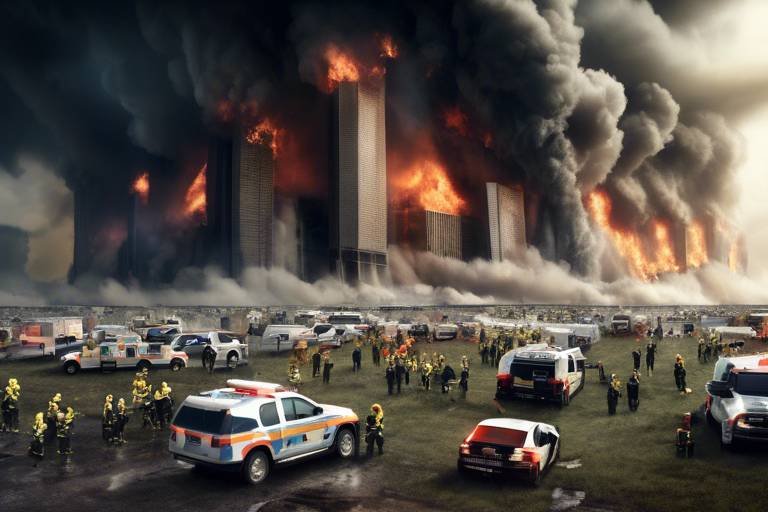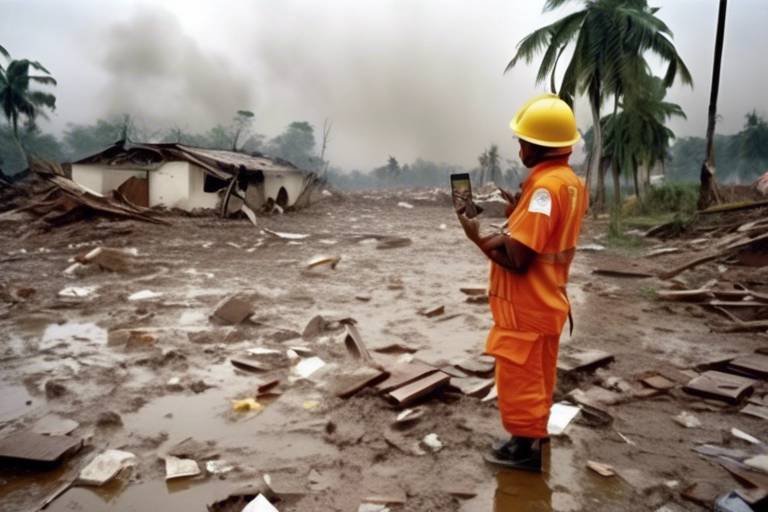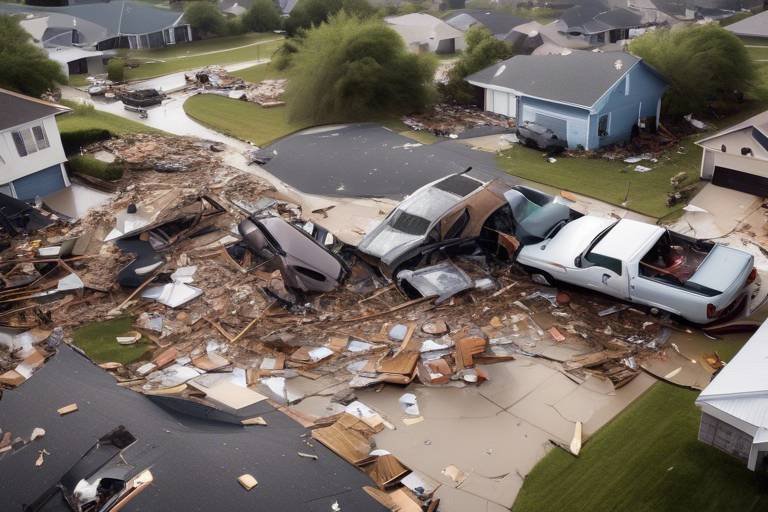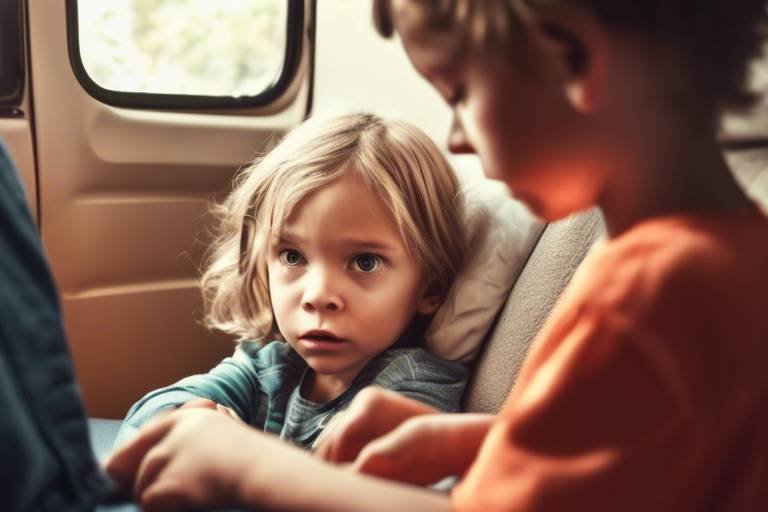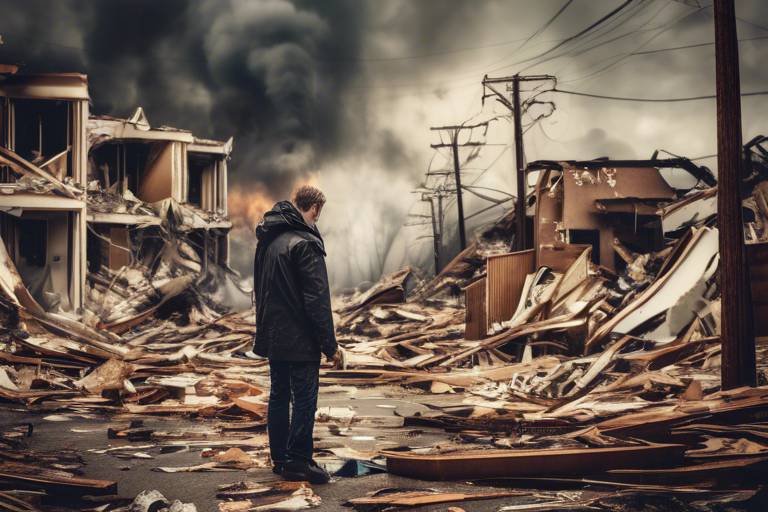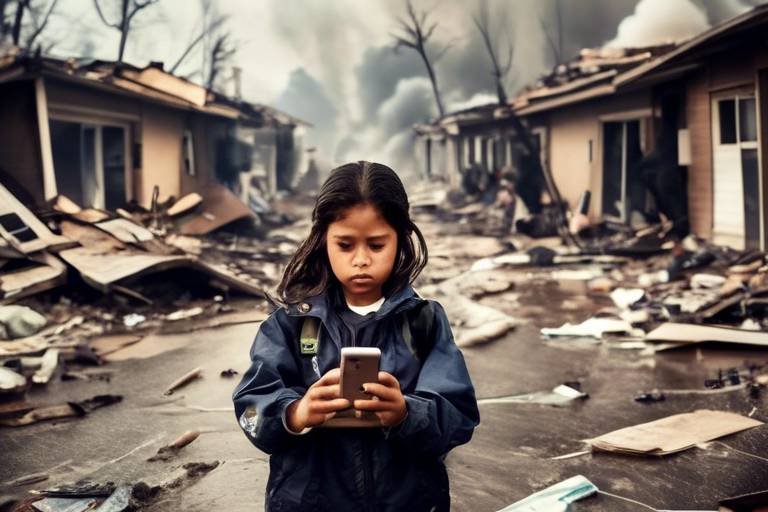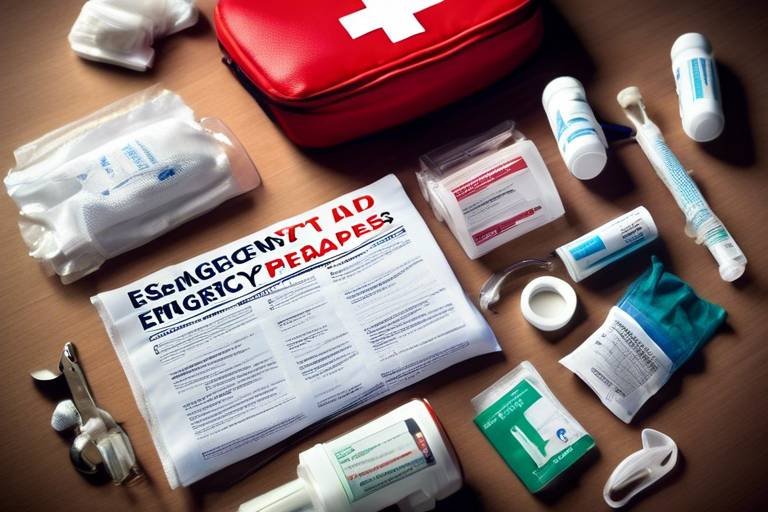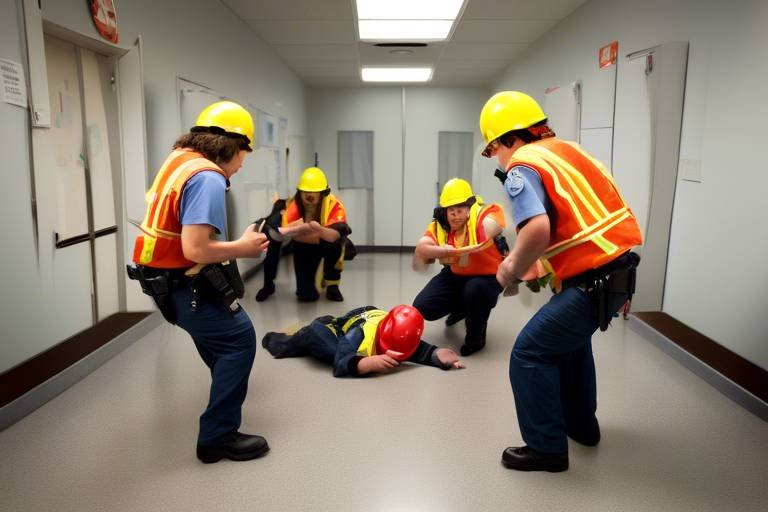Emergency Prep – Resolving Common Myths and Misconceptions
When it comes to emergency preparedness, there’s a lot of noise out there. You might have heard that you only need to worry about natural disasters, or that preparing is just too expensive. But let’s face it—these myths can lead to unnecessary panic and confusion. This article aims to debunk prevalent myths surrounding emergency preparedness, providing clarity on essential practices and encouraging individuals to take proactive measures for their safety and well-being during emergencies.
Many believe emergency kits are only necessary for natural disasters. However, emergencies can arise from various unexpected events, making preparedness essential for all situations, including health crises and man-made disasters. Think about it: a sudden illness, a fire in your building, or even a power outage can disrupt your life just as much as a hurricane. It's like having a first-aid kit—it's not just for when you cut yourself; it's there for all sorts of unexpected situations.
A common misconception is that emergency preparedness requires a significant financial investment. In reality, effective preparation can be achieved on a budget by prioritizing essential items and using available resources wisely. You don’t need to buy the fanciest gear out there. It’s about being smart and resourceful. You can build a solid emergency kit without breaking the bank!
There are numerous ways to build an emergency kit without breaking the bank, such as utilizing household items and purchasing supplies in bulk, which can significantly reduce overall costs. For example, consider these tips:
- Repurpose Items: Old blankets can keep you warm, while jars can store food or supplies.
- Buy in Bulk: Purchasing items like canned goods or batteries in larger quantities can save you money.
Many everyday items can serve multiple purposes in an emergency kit. For instance, using old blankets for warmth or repurposing jars for storage makes preparedness more accessible and affordable. Instead of tossing out those old towels, think about how they could be used for cleaning up spills or providing warmth. It’s all about creativity!
Local organizations often provide resources or host donation drives for emergency preparedness supplies, allowing individuals to acquire necessary items at little to no cost. Check with your community centers or local charities; you might be surprised at what’s available. It’s a great way to not only prepare yourself but also to connect with your community.
When building an emergency kit, focusing on essential supplies ensures that you are prepared for the most critical situations, allowing you to address immediate needs effectively without overspending. Think of it like packing for a trip—you wouldn’t take your entire wardrobe, just the essentials that you know you’ll need.
Having an emergency kit is important, but without a solid plan, individuals may struggle to respond effectively during an emergency. Developing a comprehensive plan is crucial for successful preparedness. It’s like having a map for a road trip; without it, you might end up lost in unfamiliar territory.
A family emergency plan outlines communication strategies, meeting points, and evacuation routes, ensuring everyone knows what to do when an emergency arises, leading to a more organized response. Sit down with your family and discuss what to do in various scenarios. It’s a great way to bond and prepare at the same time!
It’s essential to periodically review and update your emergency plan to accommodate changes in family dynamics, living situations, or local hazards, ensuring it remains relevant and effective. Just like you wouldn’t keep an outdated map for a road trip, you need to keep your plans fresh and current.
Some believe that emergency preparedness is solely a family concern. However, individuals living alone, seniors, and even businesses should also prioritize preparedness to ensure their safety and security during emergencies. Everyone, regardless of their living situation, can benefit from being prepared!
The belief that one can handle emergencies as they come is dangerous. Proper preparation and planning are crucial to ensure safety and minimize chaos during unexpected situations, making readiness essential. Imagine trying to fix a flat tire without a spare—it's just not going to end well!
Many assume that emergency supplies have an indefinite shelf life. However, it’s vital to check expiration dates regularly and replace items as needed to ensure effectiveness when they are required. Just like food, some supplies do spoil or lose their efficacy over time. Make it a habit to review your kit every six months.
Q1: How often should I check my emergency kit?
A: It’s advisable to check your emergency kit every six months to ensure that all supplies are up-to-date and functional.
Q2: What are the essential items I should include in my emergency kit?
A: Key items include water, non-perishable food, first-aid supplies, flashlights, batteries, and a multi-tool. Tailor your kit to your specific needs!
Q3: Is it necessary to have a plan if I live alone?
A: Absolutely! Having a plan is crucial for anyone, regardless of living situation. It helps you stay organized and calm in emergencies.

Myth 1: Emergency Kits Are Only for Natural Disasters
This article aims to debunk prevalent myths surrounding emergency preparedness, providing clarity on essential practices and encouraging individuals to take proactive measures for their safety and well-being during emergencies.
Many people operate under the assumption that emergency kits are only necessary for natural disasters like hurricanes, earthquakes, or floods. While these events certainly highlight the importance of being prepared, they are not the only situations that warrant an emergency kit. Emergencies can arise from a multitude of unexpected events, including health crises, power outages, and even man-made disasters such as chemical spills or terrorist attacks. Imagine waking up in the middle of the night to a fire alarm blaring; would you feel prepared to handle the chaos without the right supplies?
It's crucial to understand that emergencies come in various forms, and each can disrupt our lives in different ways. For instance, during a sudden health crisis, having access to basic medical supplies and food can make a significant difference. In a situation where communication lines are down, having a flashlight, batteries, and a battery-operated radio can keep you informed and safe. Thus, preparedness is not just about being ready for the worst-case scenario; it's about being equipped to handle any situation that life throws your way.
To illustrate this point further, consider the following types of emergencies that can occur:
- Health Emergencies: Sudden illnesses or injuries that require immediate attention.
- Power Outages: Extended periods without electricity due to storms or grid failures.
- Technological Failures: Cyberattacks that disrupt services and communications.
- Community Disruptions: Civil unrest or local emergencies that may require you to stay indoors.
Each of these scenarios highlights the necessity of having an emergency kit that is versatile enough to address a variety of situations. The contents of your kit should reflect the unique needs of your household and the potential risks in your area. For example, if you live in a region prone to wildfires, having a mask to filter smoke could be essential, while those in urban areas might prioritize items for personal safety during civil disturbances.
In summary, the belief that emergency kits are only for natural disasters is a dangerous myth. Preparedness is about being ready for anything life throws your way—be it a natural disaster, a health emergency, or even a man-made crisis. So, take the time to assess your needs, gather your supplies, and ensure that you are ready for any situation. Remember, it's better to be safe than sorry!
Q: What should I include in my emergency kit?
A: Your emergency kit should include essentials such as water, non-perishable food, a flashlight, batteries, a first aid kit, medications, and important documents. Tailor it to your specific needs.
Q: How often should I check my emergency kit?
A: It's a good practice to check your emergency kit at least twice a year, replacing expired items and ensuring everything is in working order.
Q: Can I use my emergency kit for everyday needs?
A: Yes! Many items in your emergency kit can also be useful for everyday situations, such as flashlights for power outages or first aid supplies for minor injuries.

Myth 2: Preparing Is Too Expensive
One of the most pervasive myths about emergency preparedness is the notion that it requires a hefty financial investment. Many people believe that assembling an emergency kit or formulating a comprehensive plan will empty their wallets, leading them to postpone or completely avoid the necessary steps for safety. However, this couldn't be further from the truth! In fact, effective emergency preparation can be achieved on a budget, allowing individuals and families to prioritize their safety without breaking the bank.
To start, it's essential to recognize that preparing for emergencies doesn't mean you have to purchase every item on a commercial survivalist checklist. Instead, you can focus on gathering essential items that will serve multiple purposes. For example, consider the following:
- Repurposing Household Items: Many everyday items can be repurposed for emergency use. Old blankets can provide warmth, while empty jars can be used for storage or even as makeshift containers for water.
- Buying in Bulk: When it comes to non-perishable food items or first-aid supplies, purchasing in bulk can significantly reduce costs. Not only do you save money, but you also ensure you have enough supplies on hand.
Moreover, community resources can play a vital role in making emergency preparedness affordable. Local organizations often host donation drives or provide resources for those in need. By taking advantage of these community programs, you can acquire necessary items at little to no cost. This not only alleviates financial burdens but also fosters a sense of community and support during challenging times.
When building your emergency kit, it's crucial to focus on prioritizing essential supplies. This means identifying the items that are absolutely necessary for your unique situation. Think about your specific needs, such as dietary restrictions or medical requirements, and tailor your kit accordingly. By concentrating on what you truly need, you can avoid overspending on unnecessary items.
In conclusion, the myth that preparing for emergencies is too expensive is simply untrue. With a little creativity, resourcefulness, and community support, anyone can develop a robust emergency preparedness plan without incurring significant costs. So, why wait? Start planning today and ensure your safety and well-being without the financial strain!

Cost-Effective Strategies for Emergency Kits
When it comes to assembling an emergency kit, many people might think it’s a daunting task that requires a hefty budget. However, preparing for emergencies doesn’t have to break the bank. In fact, there are several cost-effective strategies that anyone can implement to create a well-stocked emergency kit without spending a fortune. The key is to be resourceful and prioritize what’s truly necessary.
One of the first strategies is to repurpose household items. You’d be surprised at how many items you already own that can serve multiple purposes in an emergency. For example, an old blanket can provide warmth, while empty jars can be used for storage. Instead of buying new items, look around your home for things that can be utilized in your kit. This not only saves money but also encourages creativity in how you prepare.
Another effective way to build your emergency kit on a budget is to take advantage of bulk purchasing. Many stores offer discounts for buying items in larger quantities, which can significantly reduce costs. For instance, purchasing a bulk pack of batteries or canned food can be much cheaper than buying individual items. Additionally, consider sharing the cost with friends or family members. You can split the bulk items and create a community preparedness plan, benefiting everyone involved.
Furthermore, community resources and donations can be invaluable when building your emergency kit. Local organizations often run donation drives for emergency supplies, providing an opportunity to acquire necessary items at little to no cost. Don’t hesitate to reach out to community centers, churches, or local charities to see if they have resources available. You might find everything from first aid supplies to non-perishable food items that can bolster your kit.
Lastly, it’s crucial to prioritize essential supplies when creating your emergency kit. Focus on items that will address your immediate needs, such as water, food, first aid supplies, and necessary medications. By concentrating on these essentials, you can avoid overspending on items that may not be as critical. Here’s a simple table to help you visualize some of the must-have items for your kit:
| Essential Item | Purpose |
|---|---|
| Water | Hydration |
| Non-perishable food | Nutrition |
| First aid kit | Medical emergencies |
| Flashlight | Light source |
| Multi-tool | Versatile use |
By implementing these cost-effective strategies, you can build an emergency kit that prepares you for a variety of situations without straining your finances. Remember, it’s all about being smart with your resources and planning ahead!
Q: How often should I check and update my emergency kit?
A: It's advisable to review your emergency kit at least twice a year. This ensures that all items are in good condition and that any expired supplies are replaced.
Q: What should I do if I can't afford any supplies for my emergency kit?
A: Consider reaching out to local community organizations or charities that may offer assistance or supplies for those in need. Additionally, you can start small with items you already have at home.
Q: How can I ensure my family knows the emergency plan?
A: Regularly discuss the emergency plan with your family, conduct drills, and ensure everyone understands their roles. Keeping communication open is key to effective preparedness.

Repurposing Household Items
This article aims to debunk prevalent myths surrounding emergency preparedness, providing clarity on essential practices and encouraging individuals to take proactive measures for their safety and well-being during emergencies.
Many believe emergency kits are only necessary for natural disasters. However, emergencies can arise from various unexpected events, making preparedness essential for all situations, including health crises and man-made disasters.
A common misconception is that emergency preparedness requires a significant financial investment. In reality, effective preparation can be achieved on a budget by prioritizing essential items and using available resources wisely.
There are numerous ways to build an emergency kit without breaking the bank, such as utilizing household items and purchasing supplies in bulk, which can significantly reduce overall costs.
Repurposing household items is a fantastic way to create an emergency kit without spending a fortune. You'd be surprised at how many everyday items can serve multiple purposes when the need arises. For instance, think about those old blankets tucked away in your closet. Not only can they keep you warm during a power outage, but they can also be used for comfort if someone is feeling unwell. Similarly, empty jars can be transformed into effective storage solutions for first aid supplies or non-perishable food items.
Here are a few more examples of how you can repurpose items you already own:
- Plastic containers: Perfect for storing food or organizing small emergency supplies.
- Old backpacks: Can be used to create a portable emergency kit, making it easy to grab and go.
- Flashlights: If you have extra ones lying around, ensure they are in working order, as they can be crucial during power outages.
By creatively rethinking how you use these items, you can assemble a well-rounded emergency kit that meets your needs without the hefty price tag. Remember, preparedness doesn’t have to be expensive; it just requires a little ingenuity!
Local organizations often provide resources or host donation drives for emergency preparedness supplies, allowing individuals to acquire necessary items at little to no cost.
When building an emergency kit, focusing on essential supplies ensures that you are prepared for the most critical situations, allowing you to address immediate needs effectively without overspending.
Having an emergency kit is important, but without a solid plan, individuals may struggle to respond effectively during an emergency. Developing a comprehensive plan is crucial for successful preparedness.
A family emergency plan outlines communication strategies, meeting points, and evacuation routes, ensuring everyone knows what to do when an emergency arises, leading to a more organized response.
It’s essential to periodically review and update your emergency plan to accommodate changes in family dynamics, living situations, or local hazards, ensuring it remains relevant and effective.
Some believe that emergency preparedness is solely a family concern. However, individuals living alone, seniors, and even businesses should also prioritize preparedness to ensure their safety and security during emergencies.
The belief that one can handle emergencies as they come is dangerous. Proper preparation and planning are crucial to ensure safety and minimize chaos during unexpected situations, making readiness essential.
Many assume that emergency supplies have an indefinite shelf life. However, it’s vital to check expiration dates regularly and replace items as needed to ensure effectiveness when they are required.
Q: How often should I update my emergency kit?
A: It's recommended to review and update your emergency kit at least once a year or whenever you experience a significant life change.
Q: What are the most essential items to include in an emergency kit?
A: Key items include water, non-perishable food, a flashlight, a first aid kit, and important documents.
Q: Can I prepare for emergencies without spending a lot of money?
A: Absolutely! Repurposing household items and utilizing community resources can significantly reduce costs.

Community Resources and Donations
This article aims to debunk prevalent myths surrounding emergency preparedness, providing clarity on essential practices and encouraging individuals to take proactive measures for their safety and well-being during emergencies.
Many believe emergency kits are only necessary for natural disasters. However, emergencies can arise from various unexpected events, making preparedness essential for all situations, including health crises and man-made disasters.
A common misconception is that emergency preparedness requires a significant financial investment. In reality, effective preparation can be achieved on a budget by prioritizing essential items and using available resources wisely.
There are numerous ways to build an emergency kit without breaking the bank, such as utilizing household items and purchasing supplies in bulk, which can significantly reduce overall costs.
Many everyday items can serve multiple purposes in an emergency kit, such as using old blankets for warmth or repurposing jars for storage, making preparedness more accessible and affordable.
One of the most effective ways to gather emergency supplies without incurring heavy costs is by tapping into . Local organizations, such as food banks, churches, and community centers, often have programs designed to assist residents in preparing for emergencies. These programs may include:
- Donation Drives: Many communities host events where residents can donate supplies or receive free items essential for emergency kits.
- Workshops: Some organizations offer workshops on how to create emergency kits and plans, often providing supplies at little to no cost.
- Resource Sharing: Local networks may have platforms to share resources, allowing individuals to borrow or trade supplies.
Additionally, reaching out to local businesses can yield surprising results. Many companies are willing to donate surplus items or offer discounts on bulk purchases for community preparedness efforts. By forming partnerships with these businesses, you can enhance your emergency kit while fostering a sense of community spirit.
Don't overlook the importance of connecting with local government agencies. They often have resources and information on available assistance programs. For example, some municipalities provide free emergency preparedness kits to residents or have initiatives to help vulnerable populations, such as the elderly or low-income families. By staying informed and engaged with these resources, you can ensure that you and your community are better prepared for any situation.
Having an emergency kit is important, but without a solid plan, individuals may struggle to respond effectively during an emergency. Developing a comprehensive plan is crucial for successful preparedness.
A family emergency plan outlines communication strategies, meeting points, and evacuation routes, ensuring everyone knows what to do when an emergency arises, leading to a more organized response.
It’s essential to periodically review and update your emergency plan to accommodate changes in family dynamics, living situations, or local hazards, ensuring it remains relevant and effective.
Some believe that emergency preparedness is solely a family concern. However, individuals living alone, seniors, and even businesses should also prioritize preparedness to ensure their safety and security during emergencies.
The belief that one can handle emergencies as they come is dangerous. Proper preparation and planning are crucial to ensure safety and minimize chaos during unexpected situations, making readiness essential.
Many assume that emergency supplies have an indefinite shelf life. However, it’s vital to check expiration dates regularly and replace items as needed to ensure effectiveness when they are required.
Q: What items should I include in my emergency kit?
A: Your emergency kit should include water, non-perishable food, a flashlight, batteries, a first aid kit, necessary medications, and personal hygiene items, among others.
Q: How often should I update my emergency plan?
A: It's advisable to review and update your emergency plan at least once a year or whenever there are changes in your household or local environment.
Q: Are there any online resources for emergency preparedness?
A: Yes! Websites like Ready.gov provide comprehensive guides and checklists for creating your emergency plan and kit.

Prioritizing Essential Supplies
When it comes to building an emergency kit, is key to ensuring that you are well-prepared for any situation that may arise. It's not just about throwing a bunch of items into a bag; it's about being strategic and thoughtful about what you include. Imagine being in a crisis and reaching for your kit, only to find that it’s filled with unnecessary items that don’t address your immediate needs. That’s why you should focus on the essentials that can genuinely make a difference during an emergency.
First and foremost, consider the specific needs of your household. For instance, if you have young children, you might prioritize baby formula and diapers. If you have pets, don’t forget to include food and water for them as well. Each household is unique, and your emergency kit should reflect that. Think of it like packing for a vacation; you wouldn’t bring a winter coat to a tropical destination, right? Similarly, tailor your kit to your circumstances.
Next, it's crucial to include items that can serve multiple purposes. For example, a sturdy multi-tool can be invaluable in a variety of situations, from opening cans to making repairs. Additionally, consider adding a first aid kit, as health crises can occur during emergencies. A well-stocked first aid kit is a lifesaver, literally! You might also want to include basic medications, such as pain relievers and any prescription drugs that you or your family members may need.
Water and non-perishable food are also at the top of the priority list. The general guideline is to have at least one gallon of water per person per day for at least three days, along with enough food to last for the same duration. Think about items like canned goods, energy bars, and dried fruits—these are not only nutrient-rich but also have a long shelf life. Here’s a quick overview of what to consider:
| Essential Supply | Purpose |
|---|---|
| Water | Hydration |
| Non-perishable Food | Nutrition |
| First Aid Kit | Health emergencies |
| Multi-tool | Versatile assistance |
While it might be tempting to stock up on a variety of items, remember that less can be more. Focus on quality and functionality rather than quantity. Regularly reviewing and updating your kit will also help ensure that you are ready for any emergency situation. Check expiration dates on food and medications, and replace items as needed. Keeping your emergency supplies fresh and relevant is just as important as the supplies themselves.
Ultimately, prioritizing essential supplies is about being proactive rather than reactive. By taking the time to think through what you truly need, you can create a kit that not only meets your immediate needs but also provides peace of mind. After all, being prepared is not just a precaution; it’s an investment in your safety and well-being.
- How often should I check my emergency kit? It's recommended to check your emergency kit at least twice a year to ensure all items are in good condition and not expired.
- What should I do if I have special medical needs? Include any necessary medications and medical supplies in your kit, and consider discussing your plan with your healthcare provider.
- Can I use my emergency kit for everyday needs? While it’s good to have supplies on hand, it’s best to keep your emergency kit untouched until needed to ensure everything is ready for an actual emergency.

Myth 3: I Don’t Need a Plan if I Have a Kit
Having an emergency kit is undoubtedly a critical component of preparedness, but relying solely on it without a solid plan can leave you vulnerable in a crisis. Imagine being in the middle of a chaotic situation where every second counts, and you find yourself fumbling through your supplies without a clear direction. Frustrating, right? A well-thought-out emergency plan is your roadmap, guiding you and your loved ones through the fog of uncertainty when disaster strikes.
Think of your emergency kit as a toolbox. Yes, it contains essential tools to help you tackle specific problems, but without a blueprint or a set of instructions, you might not know how to use them effectively. Developing a comprehensive plan ensures that everyone in your household understands their roles and responsibilities. This includes knowing how to communicate, where to meet, and what to do in various scenarios.
To create an effective family emergency plan, consider the following components:
- Communication Strategies: Establish how your family will communicate during an emergency. Will you use text messages, a designated app, or social media? Make sure everyone is on the same page.
- Meeting Points: Designate safe locations where your family can gather if you’re separated. This could be a neighbor's house, a community center, or a park.
- Evacuation Routes: Familiarize everyone with the best routes to take in case you need to evacuate your home. Practice these routes to ensure everyone knows where to go.
But don’t stop at just creating a plan; it’s essential to regularly review and update it. Life changes, and so do circumstances. Maybe you’ve moved to a new neighborhood, or perhaps your family has expanded. Each of these changes can affect your emergency plan, so make it a habit to revisit it at least once a year. This ensures that your plan remains relevant and effective, adapting to your current situation.
In conclusion, while an emergency kit is a valuable asset, it is only one piece of the puzzle. Without a well-structured plan, you may find yourself overwhelmed during a crisis. So, take the time to develop a comprehensive emergency plan that complements your kit, ensuring that you and your family are truly prepared for any situation that may arise.
Q1: How often should I review my emergency plan?
A1: It's recommended to review your emergency plan at least once a year or whenever there are significant changes in your family dynamics or living situation.
Q2: What should I include in my emergency kit?
A2: Your emergency kit should include essentials like water, non-perishable food, first aid supplies, flashlights, batteries, and any personal medications you may need.
Q3: Is it necessary to have a family emergency plan if I live alone?
A3: Absolutely! A personal emergency plan is crucial for anyone, regardless of living situation, to ensure you know how to respond effectively in an emergency.

Creating a Family Emergency Plan
This article aims to debunk prevalent myths surrounding emergency preparedness, providing clarity on essential practices and encouraging individuals to take proactive measures for their safety and well-being during emergencies.
Many believe emergency kits are only necessary for natural disasters. However, emergencies can arise from various unexpected events, making preparedness essential for all situations, including health crises and man-made disasters.
A common misconception is that emergency preparedness requires a significant financial investment. In reality, effective preparation can be achieved on a budget by prioritizing essential items and using available resources wisely.
There are numerous ways to build an emergency kit without breaking the bank, such as utilizing household items and purchasing supplies in bulk, which can significantly reduce overall costs.
Many everyday items can serve multiple purposes in an emergency kit, such as using old blankets for warmth or repurposing jars for storage, making preparedness more accessible and affordable.
Local organizations often provide resources or host donation drives for emergency preparedness supplies, allowing individuals to acquire necessary items at little to no cost.
When building an emergency kit, focusing on essential supplies ensures that you are prepared for the most critical situations, allowing you to address immediate needs effectively without overspending.
Having an emergency kit is important, but without a solid plan, individuals may struggle to respond effectively during an emergency. Developing a comprehensive plan is crucial for successful preparedness.
Creating a family emergency plan is a vital step in ensuring that everyone knows how to respond when disaster strikes. Start by discussing potential emergencies that could affect your family, such as natural disasters, fires, or health-related issues. This conversation can help identify the specific needs of each family member. For example, young children might need simpler instructions, while elderly family members may require additional assistance.
Next, establish clear communication strategies. In the chaos of an emergency, having a reliable way to contact each other can be a lifesaver. Consider designating a family member who lives outside your immediate area as a point of contact, as they might be able to relay information if local networks are down. You can also use technology to your advantage; apps that provide location sharing can be very helpful.
Additionally, set up meeting points. Identify safe locations where your family can gather if you are separated during an emergency. These should be places that everyone knows how to get to, whether it’s a neighbor’s house or a local park. It's also wise to consider the various routes to these locations, as some roads might be impassable during certain emergencies.
Finally, don’t forget to practice your plan. Conduct regular drills to ensure that everyone is familiar with the steps they need to take. This practice can help reduce panic and confusion when an actual emergency occurs. Remember, the more prepared you are, the more confident you’ll feel when facing unexpected situations.
It’s essential to periodically review and update your emergency plan to accommodate changes in family dynamics, living situations, or local hazards, ensuring it remains relevant and effective.
Some believe that emergency preparedness is solely a family concern. However, individuals living alone, seniors, and even businesses should also prioritize preparedness to ensure their safety and security during emergencies.
The belief that one can handle emergencies as they come is dangerous. Proper preparation and planning are crucial to ensure safety and minimize chaos during unexpected situations, making readiness essential.
Many assume that emergency supplies have an indefinite shelf life. However, it’s vital to check expiration dates regularly and replace items as needed to ensure effectiveness when they are required.
- What should be included in an emergency kit?
Essential items include water, non-perishable food, a flashlight, a first aid kit, and necessary medications. - How often should I update my emergency plan?
It's recommended to review your emergency plan at least once a year or whenever significant changes occur in your family or living situation. - Are there resources available for emergency preparedness?
Yes, many local organizations and government agencies offer resources, workshops, and materials to help individuals prepare for emergencies.

Regularly Reviewing and Updating Plans
When it comes to emergency preparedness, having a plan is only half the battle. Just like a car needs regular maintenance to run smoothly, your emergency plan requires periodic reviews and updates to remain effective. Life is constantly changing, and so are the circumstances that could impact your safety. Whether it's a new family member, a change in your living situation, or even evolving local hazards, these factors can significantly affect your emergency response strategy.
Think about it: if you were to face an emergency today, would you feel confident in the plan you put together years ago? It’s crucial to take a step back and evaluate your plan at least once a year, or even more frequently if there are significant changes in your life. This not only helps you stay prepared but also reinforces the importance of being proactive rather than reactive.
Here are some key aspects to consider when reviewing and updating your emergency plan:
- Family Dynamics: If you’ve welcomed a new baby, had a child move out, or even lost a family member, it’s essential to update your plan to reflect these changes. Everyone should know their roles and responsibilities in an emergency.
- Living Situations: Have you moved to a new neighborhood or city? Different areas may have unique risks, such as floods, wildfires, or earthquakes. Make sure your plan includes the specific hazards of your new location.
- Local Hazards: Stay informed about potential risks in your area. For instance, if a new highway is built nearby, or if there are changes in local emergency services, adjust your plan accordingly.
Moreover, practicing your emergency plan with your family is equally important. Conduct regular drills so everyone knows what to do and where to go. This not only builds confidence but also helps identify any gaps in your plan that need addressing. Just like rehearsing for a play, the more you practice, the better prepared you'll be when the curtain rises on an emergency situation.
In summary, regularly reviewing and updating your emergency plans is not just a recommendation; it’s a necessity. By taking the time to ensure that your plan is current and practical, you’re investing in your safety and well-being. Remember, the goal is to create a plan that everyone understands and can execute effectively, turning chaos into calm when it matters most.
Q: How often should I review my emergency plan?
A: It's recommended to review your emergency plan at least once a year or whenever there are significant changes in your family or living situation.
Q: What should I do if my emergency contacts change?
A: Update your emergency plan immediately to include new contacts and ensure everyone in your household is aware of these changes.
Q: How can I practice my emergency plan?
A: Conduct regular drills with your family, discussing each person's role and the steps to take during an emergency.
Q: What if I have a pet?
A: Make sure your emergency plan includes your pets, including how to evacuate them and what supplies they may need.

Myth 4: Emergency Preparedness Is Only for Families
When it comes to emergency preparedness, many people fall into the trap of thinking it's just a family affair. This is a common misconception that can lead to serious consequences. The truth is, emergency preparedness is essential for everyone, regardless of their living situation. Whether you're a single individual, a senior citizen, or even a business owner, having a plan in place is crucial for ensuring safety and security during emergencies.
For individuals living alone, emergencies can be particularly daunting. Without a support system nearby, it's vital to have a well-thought-out plan that includes not only an emergency kit but also a strategy for communication and evacuation. Imagine being caught in a sudden storm without knowing where to go or how to reach help. It can be overwhelming, but having a plan in place can drastically reduce anxiety and confusion.
Moreover, seniors often face unique challenges during emergencies. As mobility and health issues can complicate their ability to respond quickly, it's important for them to have tailored preparedness strategies. This might include having a designated caregiver or neighbor who can assist them in case of an emergency. Preparedness is not just about having supplies; it's about creating a network of support that can be relied upon in times of need.
Businesses, too, have a critical role in emergency preparedness. Many people overlook the fact that companies should also have comprehensive plans in place to protect their employees and customers. This includes conducting regular drills, ensuring that all staff members are aware of emergency procedures, and maintaining adequate supplies. A well-prepared business can not only safeguard its assets but also foster a sense of security among its employees. In fact, businesses that prioritize emergency preparedness are often seen as more reliable and trustworthy by their customers.
In summary, emergency preparedness is a universal need that transcends family boundaries. It’s about recognizing that anyone can face unexpected situations, and having a plan can mean the difference between chaos and calm. So, whether you live alone, are part of a family, or manage a business, take the time to assess your preparedness. It's better to be safe than sorry!
- Why is emergency preparedness important for individuals living alone?
Individuals living alone may not have immediate access to help during an emergency, making it essential to have a personal plan and supplies ready.
- What should seniors consider when preparing for emergencies?
Seniors should consider their mobility and health requirements, ensuring they have a support system and tailored strategies in place for emergencies.
- How can businesses ensure they are prepared for emergencies?
Businesses can create emergency plans, conduct drills, and maintain supplies to protect their employees and customers effectively.

Myth 5: I Can Just Wing It During an Emergency
Many people carry the misconception that they can simply "wing it" when an emergency strikes. This belief is not only naive but can also lead to dangerous situations. Imagine being in the middle of a chaotic scenario, where every second counts, and you find yourself unprepared. Your mind races, and panic sets in. Without a plan, this can quickly spiral into confusion and chaos. Preparation is key to ensuring you and your loved ones remain safe during unexpected events.
Think of emergency preparedness like a fire drill. Would you run out of the building without knowing the exit routes, or would you take the time to familiarize yourself with the layout? Just like those drills, having a solid plan in place is crucial. It’s not enough to have supplies; you need to know how to use them effectively. In emergencies, stress levels skyrocket, and decision-making can become clouded. This is why having a well-thought-out plan is essential.
Consider the following aspects when preparing for emergencies:
- Communication: Establish clear communication strategies with your family or household members. Who do you call? Where do you meet? Having these details sorted out can save precious time.
- Evacuation Routes: Know the safest and quickest ways to evacuate your home or workplace. Familiarize yourself with multiple routes in case one is blocked.
- Emergency Contacts: Create a list of emergency contacts that everyone can access. This could include local emergency services, family members, and friends.
Moreover, regular practice of your emergency plan can greatly enhance your readiness. Just like athletes train for competitions, you should periodically run through your emergency procedures. This not only reinforces your knowledge but also helps reduce anxiety when a real emergency occurs. The more familiar you are with your plan, the more confident you will feel in executing it under pressure.
In conclusion, the idea that one can simply improvise during an emergency is a myth that can have grave consequences. By taking the time to develop a comprehensive emergency plan, you empower yourself and your loved ones to respond effectively when it matters most. Remember, in emergencies, preparedness can be the difference between chaos and calm.
Q: What is the first step in creating an emergency plan?
A: The first step is to assess your specific needs and risks. Consider your location, family size, and any special requirements (like pets or elderly family members).
Q: How often should I review my emergency plan?
A: It's important to review your emergency plan at least once a year or whenever there are changes in your family dynamics or living situation.
Q: What should I include in my emergency kit?
A: Your emergency kit should include essentials such as water, non-perishable food, a flashlight, batteries, a first aid kit, and any personal medications.

Myth 6: Emergency Supplies Last Forever
Many people operate under the assumption that emergency supplies can be stored indefinitely without any need for maintenance or replacement. This myth can lead to dangerous situations during a real emergency, as expired or damaged supplies can be ineffective when you need them the most. Just like any other product, emergency supplies have a limited shelf life, and it’s crucial to regularly check and update your stock to ensure everything is in optimal condition.
Consider food items, for instance. While canned goods can last a long time, they don't last forever. It's essential to keep an eye on expiration dates and rotate your stock regularly. You might think, "I'll just buy a bunch of canned beans and forget about them." But what happens when you open that can, and it’s spoiled? You could be left without a vital food source in a crisis.
Moreover, other supplies like batteries, medications, and first-aid kits also have expiration dates. For example:
| Supply | Typical Shelf Life |
|---|---|
| Canned Goods | 2-5 years |
| Water (in sealed containers) | Indefinite, but recommended replacement every 6-12 months |
| Batteries | 3-5 years |
| First Aid Supplies | 3-5 years (check individual items) |
| Medications | 1-2 years (check expiration dates) |
To avoid being caught off guard, create a schedule for reviewing your emergency supplies. Setting a reminder every six months can help you stay on top of what needs to be replaced or replenished. This simple practice not only ensures that your supplies are ready when you need them but also gives you peace of mind. Remember, being prepared is not just about having supplies; it’s about having the right supplies that are effective and safe to use.
In conclusion, the myth that emergency supplies last forever is a dangerous misconception. Regularly checking expiration dates and replacing supplies is essential for effective emergency preparedness. After all, when an emergency strikes, the last thing you want is to find out that your supplies are outdated or unusable. Stay proactive, stay safe!
- How often should I check my emergency supplies? It's recommended to check your supplies every six months to ensure everything is up to date.
- What should I do with expired supplies? Dispose of them properly and replace them with new items to maintain your emergency kit.
- Are there any supplies that never expire? While some items like sealed water can last indefinitely, it's best to replace them every 6-12 months for optimal safety.
Frequently Asked Questions
- What should I include in my emergency kit?
Your emergency kit should contain essential supplies such as water, non-perishable food, a flashlight, batteries, a first-aid kit, and important documents. Don't forget to include personal items like medications and a multi-tool. Tailor your kit to your specific needs, considering factors like family size and local risks.
- How often should I check my emergency supplies?
It's crucial to check your emergency supplies at least twice a year. This ensures that food and medications haven't expired and that all items are in good condition. Regularly updating your kit based on seasonal changes or family needs is also a smart move.
- Can I use items I already have at home for my emergency kit?
Absolutely! Many household items can be repurposed for your emergency kit. For example, old blankets can provide warmth, and jars can be used for storage. This approach not only saves money but also makes it easier to prepare.
- Is it necessary to have a family emergency plan if I have a kit?
Yes, having a family emergency plan is just as important as having a kit. A plan outlines what each family member should do during an emergency, including communication strategies and meeting points. It helps ensure that everyone knows their role, making the response more effective.
- What if I live alone? Should I still prepare for emergencies?
Definitely! Emergency preparedness isn’t just for families. If you live alone, it's essential to have a plan and an emergency kit. Being proactive can help you stay safe and organized during unexpected situations.
- How can I make emergency preparedness more affordable?
Emergency preparedness can be budget-friendly. Start by prioritizing essential items, repurpose household goods, and look for community resources or donation drives. Buying in bulk and sharing costs with neighbors can also help keep expenses down.
- How do I know when to replace items in my emergency kit?
Check the expiration dates on food, medications, and batteries regularly. If you notice any items are outdated or damaged, replace them immediately. Keeping your kit up-to-date ensures you have the necessary supplies when you need them most.
- What are the risks of not being prepared for emergencies?
Not being prepared can lead to chaos and confusion during an emergency, making it difficult to respond effectively. This can result in increased stress, potential injuries, or even loss of life. Proper preparation can significantly reduce these risks and enhance your safety.



